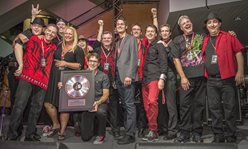17 March 2017
 Thousands of people gather from around the globe, all eyes on them. A sea of fans swarm the stage, ready to jam out. The lights come up, the crowd goes wild- no, we’re not talking about Bruce Springsteen playing a sold-out show at Madison Square Garden, but Ciena’s house band OTN Speedwagon dominating the stage at this year’s OFC. However, from the way the excitement’s building, you’d think it was Bruce.
Thousands of people gather from around the globe, all eyes on them. A sea of fans swarm the stage, ready to jam out. The lights come up, the crowd goes wild- no, we’re not talking about Bruce Springsteen playing a sold-out show at Madison Square Garden, but Ciena’s house band OTN Speedwagon dominating the stage at this year’s OFC. However, from the way the excitement’s building, you’d think it was Bruce.
Read the full post | 0 comments
By Casimer DeCusatis | Posted: 16 March 2017
OFC provides a venue to discuss breakthrough technologies, disruptive business trends, and the future of the networking industry. It’s hardly a surprise to find the discussion turning to higher data rates and the elimination of copper switches, but can these technologies really provide value in an increasingly competitive marketplace? At last year’s OFC, we saw an early demonstration of 400 Gbit/s technologies, and this year optical cross-connects will be discussed at OFC. Let’s take a closer look at these technologies, and discuss some of the challenges they face.
Read the full post | 0 comments
By Tim Doiron, Principal Analyst, Intelligent Networking, ACG Research | Posted: 15 March 2017
The idea and the desire for a fixed-mobile converged network is one that has been around a long time – even before 2004 when the Fixed Mobile Converged Alliance (FMCA) was formed. While each vendor and organization may have their own variation on FMC, the idea at least in part has been to utilize shared infrastructure across a range of mobile, enterprise and residential services to achieve networking efficiencies.
Read the full post | 0 comments
By Craig Matsumoto, Managing Editor, SDxCentral | Posted: 13 March 2017
Carefully crafted telecom standards have played an important role in building the networks we use today, but in the cloud world, where hardware is considered a throwaway commodity, standards don't carry the same importance.
Moreover, the cloud is in a hurry. Giants including Amazon Web Services (AWS), Google, and Baidu don't want to wait for standards.
Read the full post | 0 comments
By Jim Theodoras, VP Global Business Development, ADVA Optical Networking | Posted: 10 March 2017
As OFC 2017 rapidly approaches, new technologies will be at the forefront of discussions. Much to the chagrin of optical fanbois everywhere and delight of those other guys on the wrong side of communication history, optical appears to be following in the footsteps of wireless in adding more and more complex modulation schemes to eke out more and more from the same amount of stuff – all the while, pretending to ignore the inevitable Shannon limit.
Read the full post | 0 comments
By Lisa Huff, Discerning Analytics | Posted: 3 March 2017
The show floor session of the Data Center Summit at OFC 2017 will contain several presentations from industry experts that will discuss the current and next generation of optical technologies that are being developed for connectivity inside the data center. Evolving requirements of both cloud and enterprise data centers will be debated along with the entire optical networking value chain – including data center end user, equipment manufacturer and components suppliers.
Read the full post | 0 comments
By Casimer DeCusatis | Posted: 1 March 2017
One of the hot topics at this year’s OFC conference is the current state of the optical transceiver industry. Over the past decade or so, the cost of high speed optical transceivers has fallen significantly, reaching under $1 per Gigabit. Despite this, optics has not yet displaced copper cables within the data center, and many servers continue to prefer copper to optical interconnects (despite the fact that most data center switches have migrated to fiber-based interconnects). The state of optics for server interconnects, and the push for under $0.25 per Gigabit solutions, is the subject of the always lively rump session at this year’s OFC conference.
Read the full post | 0 comments
By Christine Young, Blogger, Maxim Integrated | Posted: 24 February 2017
Content-focused companies like Microsoft, Google, and Facebook are now running hyperscale data centers that require massive amounts of bandwidth. Optical networking technologies that are the foundation of these data centers are advancing at a more rapid pace today than in the past, when a generation typically spanned 10 years. These days, we’re seeing data rates double every few years. The 25Gbps per lane that’s being rolled out now will grow to 50Gbps per lane next time around, explained Andrew Sharratt, executive director of the Cloud & Data Business Unit at Maxim Integrated.
Read the full post | 0 comments
By Professor Mischa Dohler, King’s College London | Posted: 23 February 2017
Each Internet generation was believed to be the last, with designs pushed to near perfection. The first and original Internet, a virtually infinite network of computers, was a paradigm changer and went on to define the global economies of the late 20<sup>th</sup> century. After that Internet, came the Mobile Internet, connecting billions of smart phones and laptops, and yet again redefining entire segments of the economy in the first decade of the 21<sup>st</sup> century. Today, we witness the emergence of the Internet of Things (IoT), soon to connect billions of objects and starting to redefine yet again various economies of this decade.
Read the full post | 0 comments